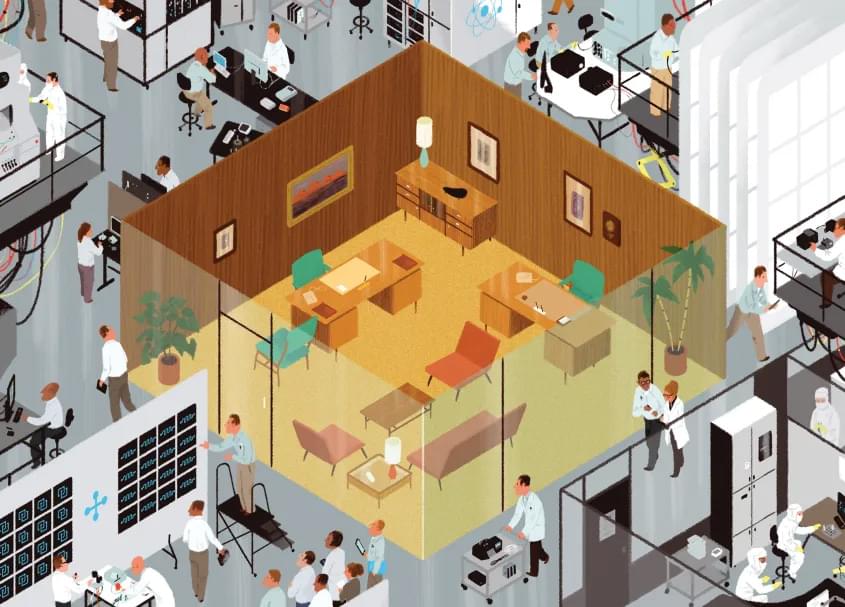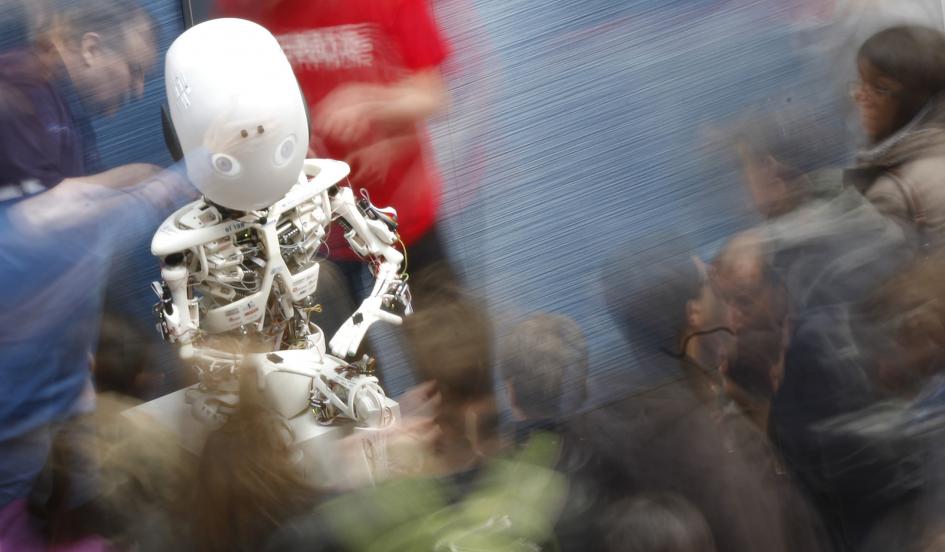Tom Simonite | Technology Review
“Nearly three-quarters of the people in HP’s research division are now dedicated to a single project: a powerful new kind of computer known as ‘the Machine.’ It would fundamentally redesign the way computers function, making them simpler and more powerful. If it works, the project could dramatically upgrade everything from servers to smartphones—and save HP itself.”
Page 11858
Apr 25, 2015
Russian Millionaire Taking Artificial Intelligence to Next Level
Posted by Seb in category: robotics/AI
By Rory Ross — NewsWeek
Despite his millions, the world of Moscow property development left Nikolay Gurianov “really bored.” Two motorbike crashes later, he reckoned it was time to move on, find a new business and swap two wheels for four.
He asked a marketeer: “What is the most interesting business that isn’t property, oil, armaments, diamonds, drugs or slavery?” And so began his career in IT—and a switch to Aston Martins.
In 2002, he set up Braintree, a technology outfit that helped Russian firms “optimise databases.” But databases too failed to ignite Gurianov. Drifting, he lit on artificial intelligence (AI). At last, here was a challenge fit for both intellect and wallet. Read more
Apr 25, 2015
A Way to Hide Corporate Data from Hackers
Posted by Seb in categories: business, hacking
By Tom Simonite — MIT Technology Review
Social-security and credit-card numbers frequently leak or are stolen from corporate networks—and surface on the black market. Adam Ghetti, founder of Ionic Security, says he has invented technology that could largely end the problem. His software keeps corporate data such as e-mails and documents encrypted at all times, except for when someone views it on an authorized computer or mobile device.
Workers at a company using Ghetti’s system can create and exchange e-mails or documents as normal. But Ionic’s software invisibly encrypts what they type on the fly. If someone tries to load a stolen document on a computer outside the company’s network, they would see only the encrypted data—a jumbled string of letters. “A network breach no longer has to mean a data breach,” says Ghetti.
Apr 24, 2015
A New Competitor for Bitcoin Aims to Be Faster and Safer
Posted by Seb in category: bitcoin
By Tom Simonite — MIT Technology Review
A Stanford professor claims to have invented a Bitcoin-like system that can handle payments faster and with more security.
The total value of the digital currency Bitcoin is now approximately $3.4 billion, and many companies and investors are working to prove that the technology can make financial services cheaper and more useful.
But Stanford professor David Mazières thinks he has a faster, more flexible, and more secure alternative. If Mazières is correct, his technology could make digital payments and other transactions cheaper, safer, and easier—particularly across borders. He released the design for his system in a white paper last Wednesday. Read more
Apr 24, 2015
To be a Space Faring Civilization
Posted by Benjamin T. Solomon in categories: astronomy, cosmology, human trajectories, innovation, science, space, space travel, transportation
Until 2006 our Solar System consisted essentially of a star, planets, moons, and very much smaller bodies known as asteroids and comets. In 2006 the International Astronomical Union’s (IAU) Division III Working Committee addressed scientific issues and the Planet Definition Committee address cultural and social issues with regard to planet classifications. They introduced the “pluton” for bodies similar to planets but much smaller.
The IAU set down three rules to differentiate between planets and dwarf planets. First, the object must be in orbit around a star, while not being itself a star. Second, the object must be large enough (or more technically correct, massive enough) for its own gravity to pull it into a nearly spherical shape. The shape of objects with mass above 5×1020 kg and diameter greater than 800 km would normally be determined by self-gravity, but all borderline cases would have to be established by observation.
Third, plutons or dwarf planets, are distinguished from classical planets in that they reside in orbits around the Sun that take longer than 200 years to complete (i.e. they orbit beyond Neptune). Plutons typically have orbits with a large orbital inclination and a large eccentricity (noncircular orbits). A planet should dominate its zone, either gravitationally, or in its size distribution. That is, the definition of “planet” should also include the requirement that it has cleared its orbital zone. Of course this third requirement automatically implies the second. Thus, one notes that planets and plutons are differentiated by the third requirement.
As we are soon to become a space faring civilization, we should rethink these cultural and social issues, differently, by subtraction or addition. By subtraction, if one breaks the other requirements? Comets and asteroids break the second requirement that the object must be large enough. Breaking the first requirement, which the IAU chose not address at the time, would have planet sized bodies not orbiting a star. From a socio-cultural perspective, one could suggest that these be named “darktons” (from dark + plutons). “Dark” because without orbiting a star, these objects would not be easily visible; “tons” because in deep space, without much matter, these bodies could not meet the third requirement of being able to dominate its zone.
Tags: 55 Cancri e, AIAA, American Institute of Aeronautics & Astronautics, atmosmax, auton, darktons, Division III Working Committee, galactica, IAU, International Astronomical Union, kyton, NASA, Nuclear and Future Flight Propulsion Technical Committee, Planet Definition Committee, planetary science, Pluton, solarmax, Space Faring Civilization, starship, Y-Dwarfs, zoeton
Apr 24, 2015
Article: Harnessing “Black Holes”: The Large Hadron Collider – Ultimate Weapon of Mass Destruction
Posted by LHC Kritik in categories: astronomy, big data, computing, cosmology, energy, engineering, environmental, ethics, existential risks, futurism, general relativity, governance, government, gravity, information science, innovation, internet, journalism, law, life extension, media & arts, military, nuclear energy, nuclear weapons, open source, particle physics, philosophy, physics, policy, posthumanism, quantum physics, science, security, singularity, space, space travel, supercomputing, sustainability, time travel, transhumanism, transparency, treaties
Harnessing “Black Holes”: The Large Hadron Collider – Ultimate Weapon of Mass Destruction
Why the LHC must be shut down
What would you have done to stop catastrophic events if you knew in advance what you know now.
We have the moral obligation to take action in every way we can.
The future is in our hands. The stakes are the highest they have ever been. The Large Hadron Collider developed by the European Centre for Nuclear Research (CERN) is a dangerous instrument. The start-up April 5 has initiated a more reckless use of LHC’s capabilities.
Continue: http://www.globalresearch.ca/the-large-hadron-collider-ultim…on/5442232
Apr 24, 2015
CERN-Critics: LHC restart is a sad day for science and humanity!
Posted by LHC Kritik in categories: astronomy, big data, complex systems, computing, cosmology, energy, engineering, ethics, existential risks, futurism, general relativity, governance, government, gravity, hardware, information science, innovation, internet, journalism, law, life extension, media & arts, military, nuclear energy, nuclear weapons, particle physics, philosophy, physics, policy, quantum physics, science, security, singularity, space, space travel, supercomputing, sustainability, time travel, transhumanism, transparency, treaties
Continue reading “CERN-Critics: LHC restart is a sad day for science and humanity!” »
Apr 24, 2015
A Tool That Lets Designers Tweak iPhone Apps Without Code
Posted by Seb in categories: hacking, innovation, software
Kyle VanHemert — Wired Jaanus Kase isn’t sure we should teach every kid to code.
Jaanus Kase isn’t sure we should teach every kid to code.
Wait, don’t grab your pitchfork just yet. He thinks it’s a perfectly noble idea, just that it ignores a basic fact: Programming as it exists today is tedious and a highly specialized skill—one that, frankly, not everyone is well-suited to. “Saying that everybody is a programmer, everybody must code, it’s dangerous,” he says. “It trivializes the art of programming. And it is an art—a craft.”
Rather than teach everyone to code, maybe it makes more sense to build tools that let some people side-step programming altogether? Read more
Apr 23, 2015
Tomorrowland: Our Journey From Science Fiction To Science Fact
Posted by Seb in category: futurism
By Steven Kotler — SingularityHub
For the past 25 years, my beat as a journalist has been covering those moments in time when science fiction became science fact. As a result, and on a good number of occasions—like when the first artificial vision implant was turned on or when the first private spaceship was launched—I was lucky enough to be in the room when history happened.
These moments are also the subject of my next book: Tomorrowland: Our Journey From Science Fiction to Science Fact, which hits stores in early May. As the title suggests, this book is an investigation into those transformational sci-fi to sci-fact moments and—more specifically—the incredibly disruptive impact they have on culture. Read more
Apr 23, 2015
Major advance in artificial photosynthesis poses win/win for the environment
Posted by Seb in category: environmental
Lawrence Berkeley National Laboratory
A potentially game-changing breakthrough in artificial photosynthesis has been achieved with the development of a system that can capture carbon dioxide emissions before they are vented into the atmosphere and then, powered by solar energy, convert that carbon dioxide into valuable chemical products, including biodegradable plastics, pharmaceutical drugs and even liquid fuels.
Scientists with the U.S. Department of Energy (DOE)‘s Lawrence Berkeley National Laboratory (Berkeley Lab) and the University of California (UC) Berkeley have created a hybrid system of semiconducting nanowires and bacteria that mimics the natural photosynthetic process by which plants use the energy in sunlight to synthesize carbohydrates from carbon dioxide and water. However, this new artificial photosynthetic system synthesizes the combination of carbon dioxide and water into acetate, the most common building block today for biosynthesis.
“We believe our system is a revolutionary leap forward in the field of artificial photosynthesis,” says Peidong Yang, a chemist with Berkeley Lab’s Materials Sciences Division and one of the leaders of this study. “Our system has the potential to fundamentally change the chemical and oil industry in that we can produce chemicals and fuels in a totally renewable way, rather than extracting them from deep below the ground. Read more








